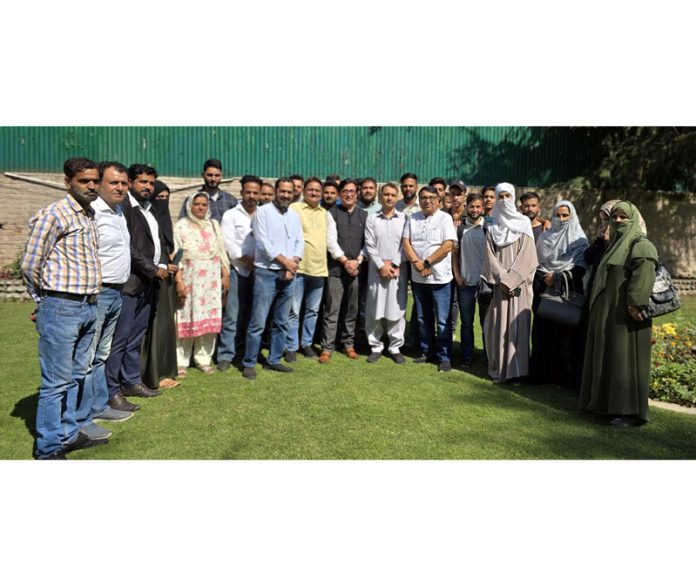The most emblematic garment in South Asian, or more specifically Indian culture is the saree. This timeless piece of clothing is more than just fabric, in most houses it’s a symbol of heritage passed down through generations. From grandmothers who first bought it to mothers who lovingly lent it, the saree often serves as an inexpensive yet invaluable family heirloom.
However, the art of draping a saree — an essential skill in bringing this garment to life — is slowly fading from memory. Ironically, those who seem to be most affected by this loss are A-listers and celebrities. Today, many actors and celebrities don’t drape their own sarees, even for significant events like weddings.

Instead, they rely on professionals to do it for them; enter Dolly Jain, a professional saree draper who has become a go-to expert in this art form. Dolly Jain’s journey began when her mother-in-law insisted that the then 20-year-old learn to drape the five-and-a-half meters of fabric every day. What started as a daily routine turned into a passion and Dolly's expertise eventually caught the eye of the monarchs of the the fashion world, leading her to work with Nita Ambani, wife of India’s richest man Mukesh Ambani.
Dolly has since become the preferred draper for the Ambani family especially for high-profile events like the wedding of their son, Anant Ambani with Radhika Merchant. A post shared by Dolly Jain 🇮🇳 (@dolly.jain) While Dolly does preserve the conventional ways of draping, a new wave of influencers are re-imagining this age-old practice — for those who cannot pay for her exorbitant fees, these influencers make the saree accessible and trendy for younger generations who might otherwise feel hesitant to try it.
How social media is modernising this traditional garment One such influencer is Natasha Thasan, the pioneer of ‘Drape Therapy.’ Also known as ‘The Saree Architect’ or ‘Apsara,’ Natasha has garnered a global following with her unconventional draping styles. With roots in Sri Lanka, Natasha is a strong advocate for her heritage, but she also believes that the saree should be worn by all, regardless of cultural background or gender.
Her innovative drapes, which can be styled in under a minute, challenge traditional methods and redefine what it means to wear a saree in today’s world. A post shared by Saree Architect (@natasha.thasan) Another icon in the industry is Pooja Jagadeesh.
Unlike many who grow up wearing sarees, Pooja embraced the garment later in life. Her mother’s collection of sarees inspired her, but it wasn’t until a few years ago that she began to wear them herself. Looking for ways to integrate the garment into her lifestyle, she experimented with draping techniques that transitioned the saree from a traditional, ceremonial garment to something she could wear casually for work or travel.
A post shared by Pooja Jagadeesh (@poojajagadeesh) Adding another layer of modernity to the saree is Ashwini Narayan, a saree stylist and drape artist on a mission to make the saree hip, cool, and easy for everyone. Through her work with sarees and hand-looms, Ashwini has embraced a more sustainable way of living; often drawing inspiration from her parents, who exemplified a zero-waste lifestyle by recycling and re-purposing everything, Ashwini’s philosophy is simple — to her, a saree is forever! A post shared by Ashwini Narayan (@winnynarayan) Have these influencers really changed things? In recent years it is undoubtedly true that the saree has seen a resurgence, thanks in part to innovative styling that blends tradition with modern fashion. Indian brands like The Saree Sneakers have popularised the idea of pairing sneakers with sarees, while in Sri Lanka, designer brand Urban Drape specialises in sarees paired with crop tops.
These non-traditional ways of wearing a saree might raise eyebrows among purists, but they offer a fresh and fun way for people to express their authentic selves. The saree’s significance goes beyond its aesthetic appeal. In her essay Sari and the Narrative of Nation in 20th-Century India, author Aarti Kawlra discusses how the saree emerged as a symbol of “Indianness”during nationalist movements in the early 20th century.
Aarti writes that the saree became an emblem of South Asian culture and feminine beauty saying, “So central was the sari to the nationalist narrative that, from the early part of the 20th Century, it was employed to create the persona of a 'proper' Indian woman within the frame of increasingly gendered societal norms.” This deep cultural significance adds another layer of importance to the modern resurgence of saree draping. Thanks to these influencers, the art of saree draping is not just surviving — it’s thriving in the ever changing fashion ecosphere.
By modernising this ancient practice, they are ensuring that the saree remains relevant, trendy, and accessible to all..



















